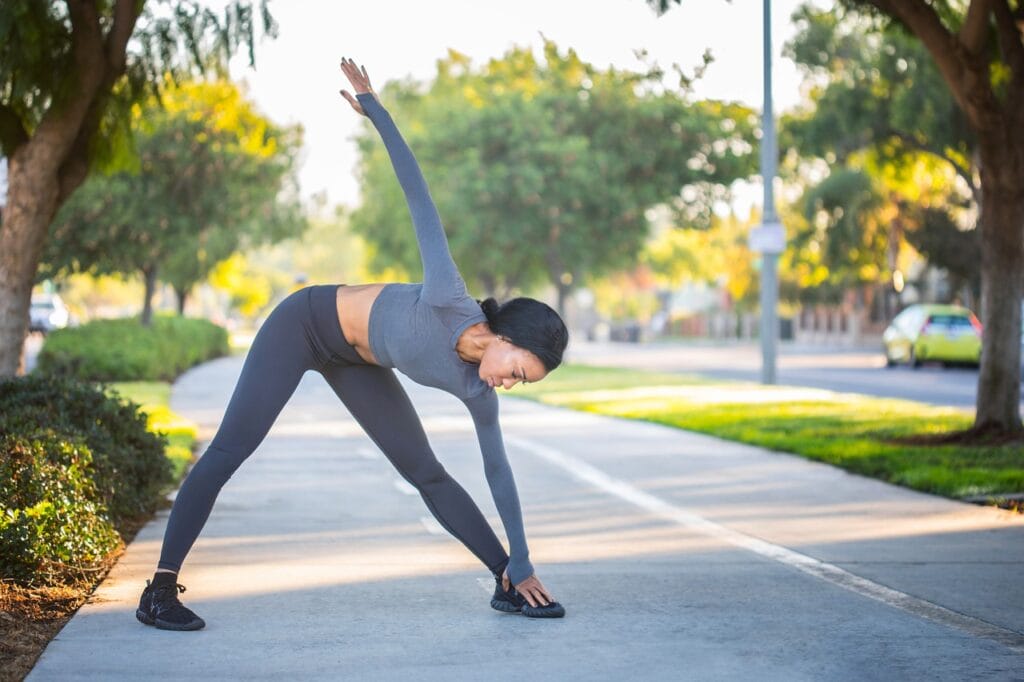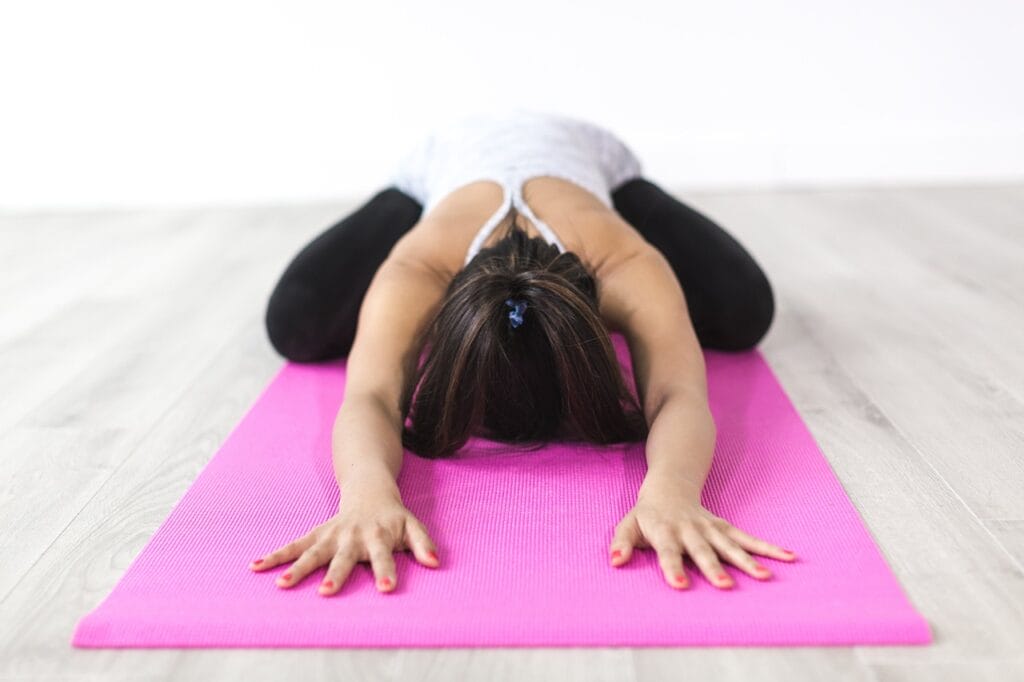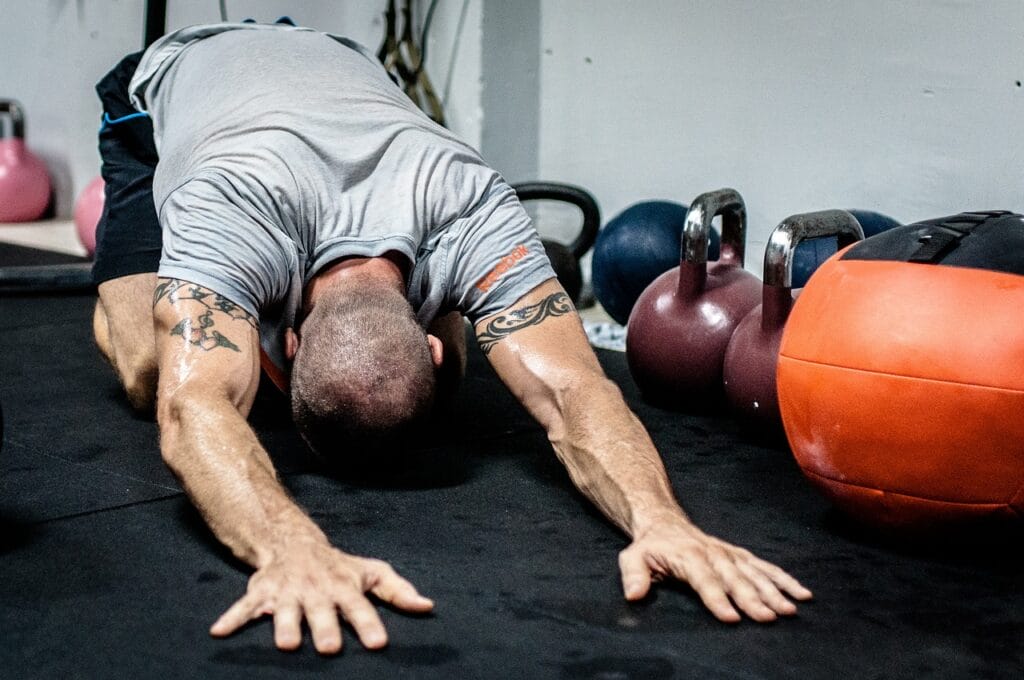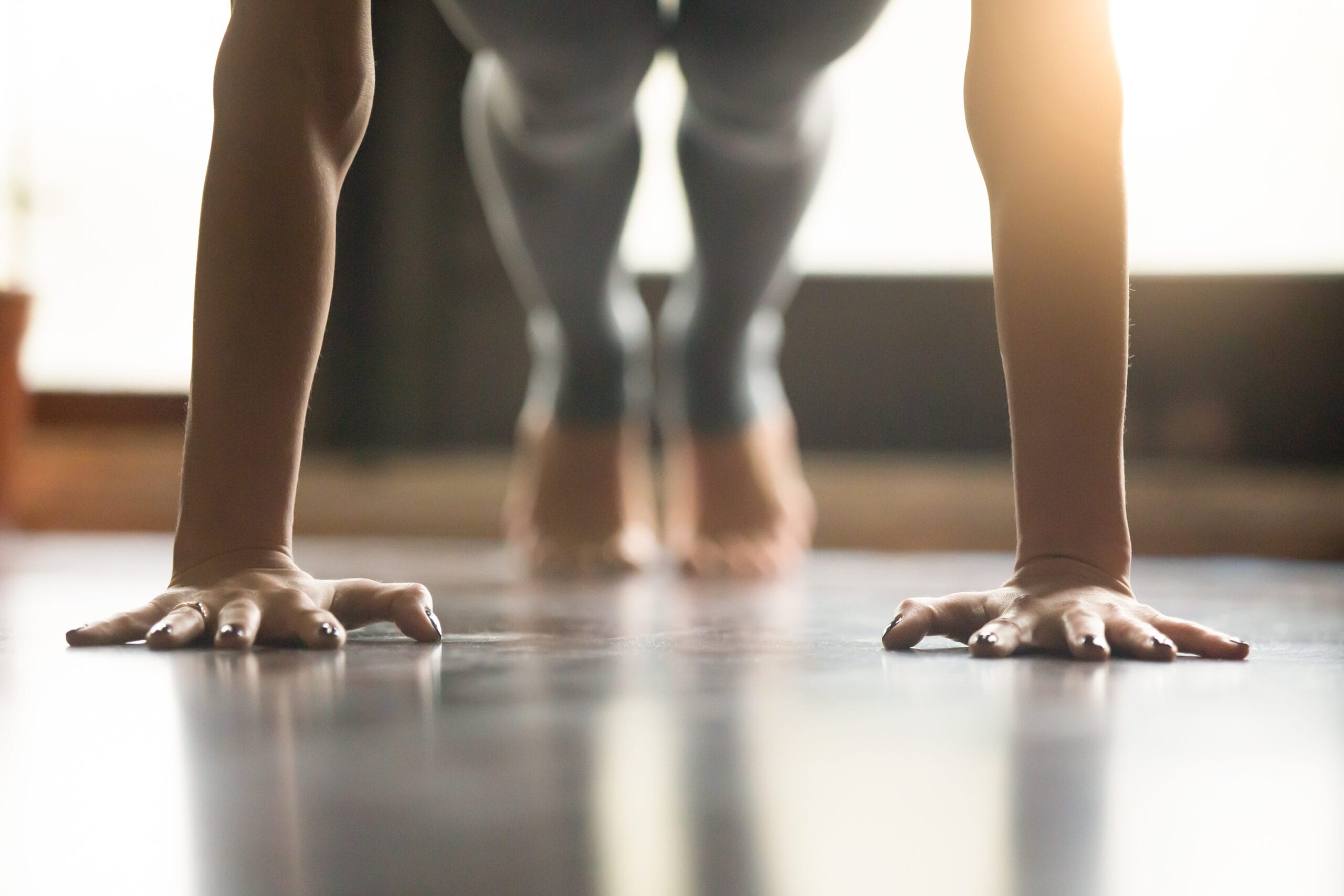
There are a lot of ways to improve flexibility, but few are as controversial as ballistic stretching.
In a nutshell, ballistic stretching is a dynamic approach that involves taking your joints and muscles to their natural end range and then gently rocking or bouncing to push your muscles a little farther.
In other words, ballistic stretching involves doing something most of us have been told not to do.
And as a physical therapist, I too was told that ballistic stretching, in general, is a bad idea.
But if athletes are doing it, it must work right?
Well, ballistic stretching can certainly offer some flexibility benefits, but it all depends on your fitness level and how you’re doing it.
Before you start including ballistic stretching into your workout routines, make sure you know the whole story (including how to do it correctly in the first place).
But don’t worry, you’ve come to the right place.
In this article, we’ll dive into the world of ballistic stretching, exploring what it is, how it differs from other stretching methods, its benefits, its risks, and the proper techniques that should be implemented for optimal safety.
After reading, you’ll be able to decide for yourself whether or not ballistic stretching is worth the effort.
Understanding Ballistic Stretching
Ballistic stretching is a form of dynamic stretching that involves rapid, bouncing movements to stretch muscles and increase flexibility.
Unlike static stretching, which involves holding a stretch position, ballistic stretching uses momentum to push muscles beyond their normal range of motion.
This method is often used by athletes and individuals looking to enhance their flexibility for activities that involve explosive movements.
Key characteristics of ballistic stretching include:
- Bouncing Movements: Ballistic stretches typically involve pulsing, rocking, or rhythmic bouncing movements that propel the body part being stretched in and out of the stretched position. This dynamic approach is meant to gradually increase the muscle’s length.
- Utilization of Inertia: Ballistic stretching relies on the principle of inertia, using the body’s momentum to generate the stretch. This can lead to a more forceful and rapid stretch compared to other stretching methods.
- Specific Muscle Groups: Ballistic stretches often target specific muscle groups, such as hamstrings, quadriceps, and hip flexors. The bouncing movements are tailored to the muscles relevant to the intended activity.
- Sports-Specific Application: Athletes, especially those involved in sports requiring explosive movements, may incorporate ballistic stretching into their warm-up routines. The goal is to prepare the muscles for the rapid contractions and dynamic actions associated with their sport.
Ballistic vs Dynamic Stretching
Ballistic stretching is technically a type of dynamic stretching, but they differ in their approach and execution.
Here’s a comparison between ballistic and dynamic stretching:
| Dynamic Stretching | Ballistic Stretching |
| Movement throughout full range of motion (ROM) | Starts at end-range |
| Movement stops at natural end-range | Momentum used to stretch past end-range |
| Safe for everyone | Best suited for people with better flexibility |
| Great for warm-ups | Risk of over stretching and injury |
Dynamic Stretching
1. Controlled Movements
- Dynamic stretching involves controlled, smooth, and deliberate movements.
- Each stretch is taken to the end range of motion but without bouncing or jerking.
2. Muscle Activation
- Dynamic stretches engage the muscles actively through a full range of motion.
- Movements are typically repetitive and flow in a controlled manner.
3. Warm-Up
- Dynamic stretching is often used as a warm-up before physical activities or exercise.
- It helps increase blood flow, heart rate, and body temperature.
4. Reduced Injury Risk
- The controlled nature of dynamic stretching reduces the risk of overstretching and injury.
- It is generally considered safer for individuals of various fitness levels.
5. Suitable for All
- Dynamic stretching is suitable for a wide range of individuals, including beginners and those with various fitness levels.
Ballistic Stretching
1. Bouncing Movements
- Ballistic stretching involves bouncing or jerking movements to extend the muscles beyond their normal range of motion.
- It relies on the use of momentum to push the muscles.
2. Explosive Nature
- Ballistic stretching is more explosive and forceful compared to dynamic stretching.
- It may mimic the demands of activities that involve quick, explosive movements.
3. Sports-Specific
- Ballistic stretching is sometimes used by athletes in sports that require explosive actions.
- It aims to prepare the muscles for the rapid contractions associated with certain sports.
4. Caution Required
- Ballistic stretching carries a higher risk of over-stretching, muscle strains, and injuries.
- Individuals with certain health conditions or beginners may need to approach it with caution.
5. Advanced Level
- Ballistic stretching is often considered more advanced and may be suitable for individuals with a good baseline of flexibility and body awareness.

Choosing Between Ballistic and Dynamic Stretching
- Individual Fitness Level
- Dynamic stretching is generally more accessible to individuals of various fitness levels.
- Ballistic stretching may be more appropriate for those with a higher level of flexibility and experience.
- Activity-Specific Needs
- Athletes engaged in activities that involve explosive movements may incorporate ballistic stretching into their warm-up routines.
- Individuals focusing on general flexibility and injury prevention may prefer dynamic stretching.
- Risk Tolerance
- Individuals with a lower risk tolerance or concerns about potential injury may opt for dynamic stretching.
- Those comfortable with the increased risk and seeking specific benefits may consider ballistic stretching.
Overall, while both ballistic and dynamic stretching aim to improve flexibility through dynamic movements, the key difference lies in the intensity and nature of the movements.
Individuals should choose the form of stretching that aligns with their fitness goals and experience level, while always prioritizing safety and proper technique.
That said, there are potential benefits for using ballistic stretching in your training:
Potential Benefits of Ballistic Stretching
Improved Dynamic Flexibility
Ballistic stretching can offer rapid improvements in flexibility, helping athletes improve mobility in shorter periods.
The bouncing movements may also mimic the demands of certain sports and help the muscles adapt to rapid changes in length.
Time-Efficient Warm-Up
Ballistic stretching can serve as a time-efficient warm-up routine, especially before activities that involve dynamic movements.
The quick, rhythmic motions increase blood flow, warming up the muscles and preparing them for more intense physical exertion.
You can also often stretch multiple muscle groups at a time for quicker warm ups (like the “pancake” position shown in the video above).
Muscle Elasticity
The bouncing actions in ballistic stretching promote muscle elasticity, allowing the muscles to stretch and return to their original length more efficiently.
This may contribute to a more efficient stretching, but honestly, I’ve been unable to find any great evidence to suggest this is true.
Potential Concerns with Ballistic Stretching
Increased Risk of Injury
Ballistic stretching involves rapid and rather forceful movements, which can potentially lead to muscle strains or other injuries.
The quick, pulsing nature of ballistic stretches may exceed the normal range of motion, putting stress on muscles and connective tissues.
Limited Control
Unlike static stretching, ballistic stretches involve less control over the range and speed of motion.
And this lack of precision can result in over-stretching, putting inexperienced folks at an increased risk of injury.
Not Suitable for Everyone
Ballistic stretching may not be suitable for individuals with certain health conditions, such as muscle or joint injuries, as the forceful movements can exacerbate these issues.
It’s crucial to consider individual fitness levels and health status before incorporating ballistic stretching into a routine.
Beginners or folks with limited flexibility to begin with should consider other more traditional forms of stretching before opting for ballistic moves.
Specific Technique Required
Unlike static or dynamic stretching, to perform ballistic stretches safely and effectively, individuals need to know what they’re doing.
Without proper guidance, there’s a higher risk of executing the movements incorrectly, leading to potential injury.
Overall, while ballistic stretching can be a valuable tool when used appropriately, individuals should exercise caution and consider their own fitness levels and health conditions before trying it.
And if you have any pre-existing injuries or health concerns, it’s a smart idea to talk to your physician or local physical therapist for guidance.

Proper Techniques for Ballistic Stretching
But in case you feel up to it and wanna give it a try, at least make sure you do it correctly:
- Warm-Up First: Always perform a light cardiovascular warm-up before engaging in ballistic stretching to ensure your muscles are adequately prepared.
- Gradual Progression: Start with gentle and controlled bouncing movements, gradually increasing intensity. Avoid excessive bouncing or force to prevent injury.
- Focus on Major Muscle Groups: Target major muscle groups, such as hamstrings, quadriceps, and hip flexors. Perform specific ballistic stretches for each muscle group.
- Incorporate Breathing: Coordinate your breathing with the movements. Exhale during the stretch and inhale during the return to the starting position.
- Don’t push past pain: If your stretches become painful, it’s time to stop. Don’t continue pushing past the point of pain because you’ll put yourself at risk of tearing something.
Examples of Ballistic Stretches
Hamstring Bounces
- While standing with feet shoulder-width apart, hinge at the hips and reach toward the toes.
- Perform small, rapid bouncing movements, allowing the upper body to move up and down toward the toes.
Hip Flexor Bounces
- Kneel on one knee with the opposite foot in front, forming a lunge position.
- Lean forward until you feel a stretch in the stationary hip flexor and perform rocking movements, gently lowering the hips toward the ground.
Ballistic Pancake
- Sit on floor with feet spread apart.
- Lean forward as if you’re trying to rest your chest on the ground, when you get to your end-range, gently pull back and then lean forward, gently pushing past your end-range; bounce back and forth, increasing your ROM as tolerated.
Final Thoughts
As a physical therapist, I appreciate the benefits ballistic stretching can offer, but I’m a little weary of the average home-gymer trying to implement these into their daily routine.
I agree that ballistic stretching, when performed with proper technique and caution, can be a valuable tool for enhancing dynamic flexibility and athletic performance.
But I also think it’s best left for the more flexible folks out there.
I feel like you need a certain level of flexibility to be able to do these ballistic moves safely and if you try to do ’em without this baseline level of mobility, you’re just asking for trouble.
You also need the control necessary to make sure you don’t bounce too hard or too far and again – if you don’t have a baseline level of flexibility, you likely don’t have the control necessary to do this safely.
Personally, I think it makes sense to start with static and dynamic stretches and maybe work your way up to these more advanced ballistic moves.
Either way, it’s definitely an interesting topic.
Anyway, if you’ve read all the above info and feel confident that you can handle these stretches, I say give it a try.
Just make sure you warm up before and you listen to your body.


